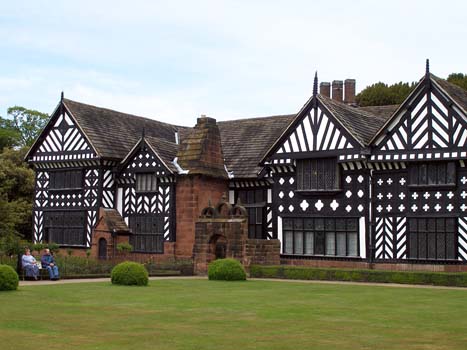 |
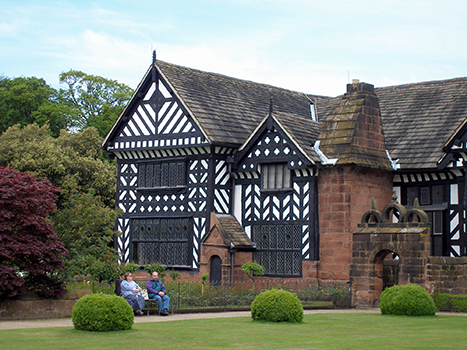 |
|
| Speke Hall, south west elevation | Speke Hall, west end of south west side | |
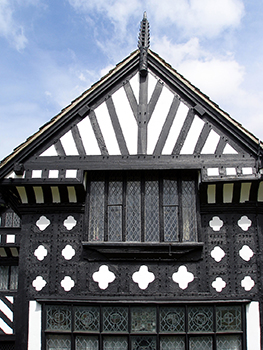 |
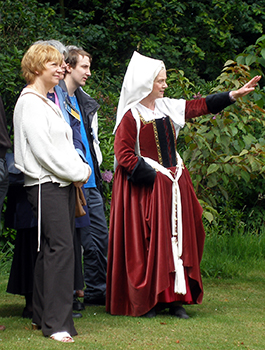 |
|
| Detail of gable | Our guide in Tudor costume | |
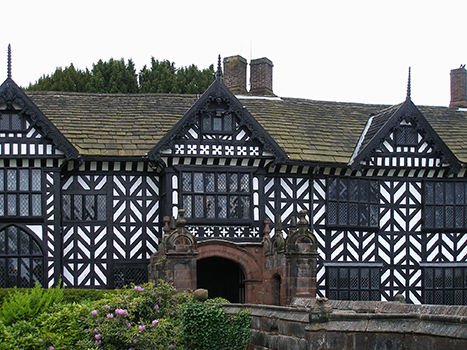 |
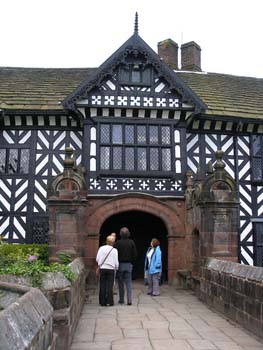 |
|
| North-East side of the Hall | The doorway |
 |
 |
|
| Speke Hall, south west elevation | Speke Hall, west end of south west side | |
 |
 |
|
| Detail of gable | Our guide in Tudor costume | |
 |
 |
|
| North-East side of the Hall | The doorway |
Speke Hall, a National Trust Property, lies on the north bank of the Mersey, within a few hundred metres of the end of the runway for Liverpool airport. Like Bramall and Little Moreton Halls in Cheshire, it is a splendid survivor of Tudor timber-framed architecture. Given its location, Speke Hall is not on the normal tourist trail but while you are in the same area you can visit the Palm House in Stanley Park (SJ 378 977) or Sudley House ( SJ 388 866) the house of a wealthy Liverpool Merchant.
It is believed that there was a house on this site before the present one, which was commenced in about 1490. However, the manor of Speke was mentioned in the Domesday Survey. The Norris family acquired the estate in the late 14th century and the construction of the present house was begun by William Norris who was knighted after the Battle of Stoke in 1487. He died in 1506 and the work was continued by his son, also William, who died in 1568. Edward, the son of the latter William continued work and he died in 1606. Between 1490 and 1506 the Great Hall was built, followed by the Great Parlour between 1525 and 1535. At the same time the North Bay was added. The west wing was added between 1540 and 1570 and the south wing extended. Edward Norris added the north range in 1598 and the porch was added to the Great Parlour in 1612.
The period during which the house was built encompassed almost all the Tudor period including the Reformation and the religious strife in the reign of Queen Mary. The Norris family remained Catholic after the Reformation and in the early 17th century their fines for recusancy were a financial drain. The house has small secret rooms to hide priests. Thomas Norris was the first to be a Protestant and he inherited just after the Civil War, in 1651. His uncle, Edward, had held Liverpool for the Royalists and the Norris estate was seized by the Parliamentarians. The family regained the estate in 1662, following the Restoration. By the early 18th century the estate passed through an heiress to her husband, Lord Beauclerk, the son of the Duke of St. Albans, who was the child of Charles II and Nell Gwynn. The house was neglected and fell into disrepair. In 1795, after three generations of Beauclerks, the estate was sold to Richard Watt, a merchant who had made his money from Jamaican sugar plantations. He acquired 2,400 acres and the house for £73,000 but died the following year, leaving the estate to his great nephew, Richard, then only ten years old. Richard Watt carried out restoration of Speke Hall when he became of age. His son, also Richard, succeeded to the estate but died young. However, his son, another Richard undertook major restoration work. The house was then leased to a ship owner, Frederick Leyland, who undertook further work on the ground floor between 1867 and 1878. Miss Adelaide Watt inherited the house when she was 21 in 1878 and moved to live at the hall. She arranged to leave the house to the National Trust and died in 1943. As a consequence of these changes in ownership, none of the original furniture of the house remains. The present furniture is mainly mid 19th century. Most of the land surrounding the house was sold before the WW II with Chapel Farm becoming Liverpool Aerodrome.